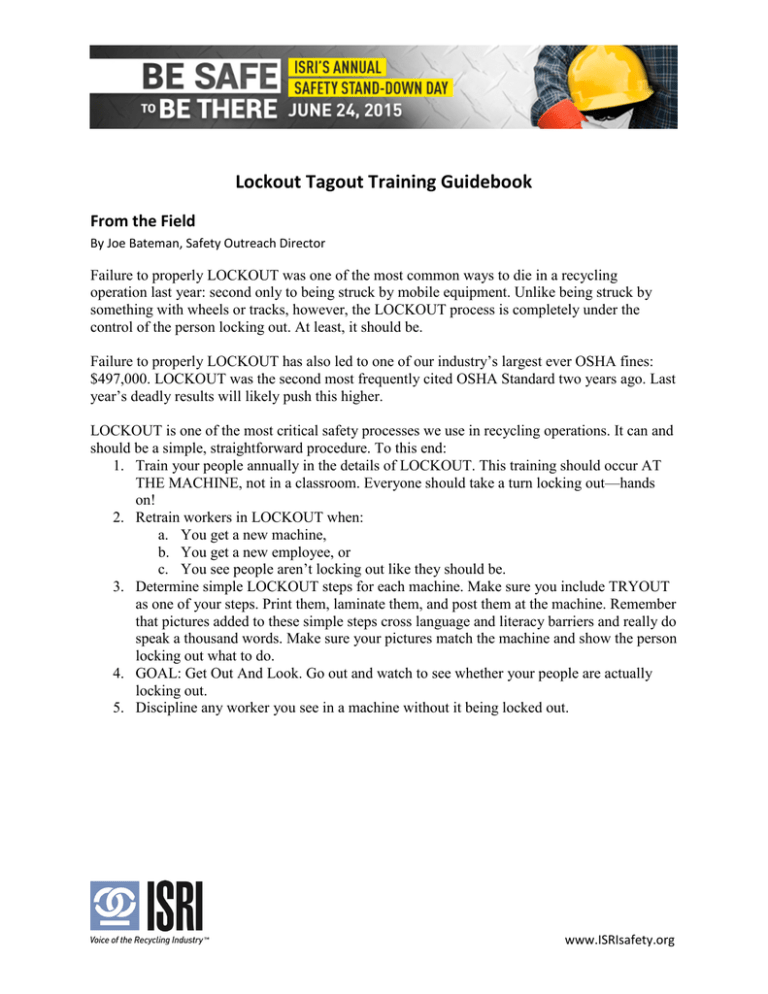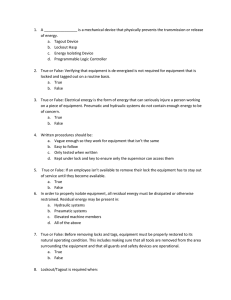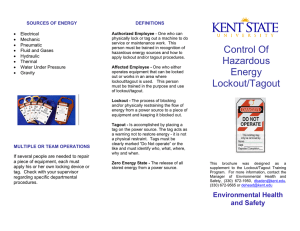Lockout Tagout Training Guidebook
advertisement

Lockout Tagout Training Guidebook From the Field By Joe Bateman, Safety Outreach Director Failure to properly LOCKOUT was one of the most common ways to die in a recycling operation last year: second only to being struck by mobile equipment. Unlike being struck by something with wheels or tracks, however, the LOCKOUT process is completely under the control of the person locking out. At least, it should be. Failure to properly LOCKOUT has also led to one of our industry’s largest ever OSHA fines: $497,000. LOCKOUT was the second most frequently cited OSHA Standard two years ago. Last year’s deadly results will likely push this higher. LOCKOUT is one of the most critical safety processes we use in recycling operations. It can and should be a simple, straightforward procedure. To this end: 1. Train your people annually in the details of LOCKOUT. This training should occur AT THE MACHINE, not in a classroom. Everyone should take a turn locking out—hands on! 2. Retrain workers in LOCKOUT when: a. You get a new machine, b. You get a new employee, or c. You see people aren’t locking out like they should be. 3. Determine simple LOCKOUT steps for each machine. Make sure you include TRYOUT as one of your steps. Print them, laminate them, and post them at the machine. Remember that pictures added to these simple steps cross language and literacy barriers and really do speak a thousand words. Make sure your pictures match the machine and show the person locking out what to do. 4. GOAL: Get Out And Look. Go out and watch to see whether your people are actually locking out. 5. Discipline any worker you see in a machine without it being locked out. www.ISRIsafety.org When is Lockout/Tagout Required? Servicing, maintaining, or un-jamming equipment where: • • • Hazardous energy exists Unexpected start-up could occur Either of these could injure a worker When Shall Lockout/Tagout Be Used? • • • Employees are required to remove or bypass a safety device Employees are required to place any part of their body in harm’s way Employees are exposed to hazardous energy What Should You Remember? 1. Lockout is not just for when things go wrong. 2. Lockout is not just for maintenance workers. 3. Make sure people understand AND use it. www.ISRIsafety.org Examples of Energy Sources • • • • • • • • • • Mechanical Thermal Hydraulic Pneumatic Magnetic Gravity Electrical Gas Water Other stored energy (i.e. springs, capacitors) www.ISRIsafety.org Where to Begin 1. First, conduct a HAZARD ASSESSMENT by identifying each piece of equipment that is used, serviced, or maintained a. Include broken or stored equipment 2. Then, determine the requirements for lockout a. If there is more than one primary energy source to the equipment, document each source 3. Document all energy sources a. Hidden b. Direct 4. The hazard posed 5. The magnitude or measurable degree of danger 6. Special or unusual conditions 7. Proper isolations and devices www.ISRIsafety.org Types of Lockout Devices • • • • • • • • • • • • Locks Blocks Chains Multilock hasps Wheel valve covers Ball valve covers Gladhand locks Overhead crane controls/plugs Breakers Wall switches Airlines Gas Cylinders Requirements for Lockout/Tagout Devices • • • • Durable Standardized Substantial Identifiable www.ISRIsafety.org Typical Lockout Procedure 1. Notify affected employees 2. Use the specific steps as written in your own procedure manual 3. Shut off energy source(s) to affected equipment - Use normal stopping or running procedures for the machine 4. Isolate the equipment from the energy source 5. Affix locks and tags to each energy source controlling device 6. Relieve all stored energy from capacitor banks, springs, compressed air, hydraulics, etc. 7. Verify isolation of energy has occurred by trying to start equipment Removal of Lockout/Tagout and Start-Up Procedures 1. Ensure that nonessential items are removed from equipment 2. Ensure that equipment components are intact 3. Check area to ensure that all affected employees are safely positioned or removed from the area 4. Notify all affected employees and site supervisor before reenergizing the equipment 5. Remove lockout/tagout devices 6. Reenergize equipment to ensure safe operation www.ISRIsafety.org Lockout/Tagout Quiz 1. Place numbers from 1 to 7 in the blanks indicating the correct order of steps to be taken in lockout/tagout! ___ Isolate equipment ___ Verify isolation ___ Control stored energy ___ Shut down equipment ___ Prepare for shutdown ___ Apply lockout/tagout devices ___ Removal of locks 2. Lockout/Tagout is a system used to ensure that equipment you’ve isolated and deenergized to work on remains shut down. True___, False___ 3. In a tagout, a tag is placed on all primary and secondary energy sources. True___, False___ 4. You know the equipment is safe when the power has been shut down. True___, False___ 5. It’s a good idea to have a pre-job briefing with your co-workers before a lockout operation. True___, False___ 6. Locks should be removed only by the person who installed them. True___, False___ 7. Kinetic energy is energy an object has when it is in motion. True___, False___ www.ISRIsafety.org (Lockout/Tagout Quiz continued) 8. In preparing for a shutdown, gravity is not a concern. True___, False___ 9. Which of the following must an employee know before starting to work on a piece of equipment. a) types of energy to be controlled, b) magnitude of energy to be controlled, c) hazards of energy to be controlled, d) method and means to control the energy. 10. Which of the following must be notified prior to equipment shutdown for repair? a) plant manager, b) supervisor, c) safety person, d) affected employees. 11. Which of the following would be part of equipment isolation? a) closing valves, b) locking out feeders, c) turning off power, d) releasing hydraulic pressure, e) releasing steam pressure, f) blocking movement of parts, g) releasing spring tension. 12. Which of the following would be part of control of stored energy? a) closing valves, b) locking out feeders, c) turning off power, d) releasing hydraulic pressure, e) releasing steam pressure, f) blocking movement of parts, g) releasing spring tension. 13. Verifying isolation involves: a) putting locks on the equipment, b) putting a tag on the equipment, c) attempting to turn the machine on. www.ISRIsafety.org Lockout/Tagout Quiz Answers 1. Order: 3, 6, 5, 2, 1, 4, 7 True/False: 2. T 3. T 4. F 5. T 6. T 7. T 8. F Multi-choice: 9. Abcd 10. D 11. Abc 12. D 13. Defg 14. c www.ISRIsafety.org

